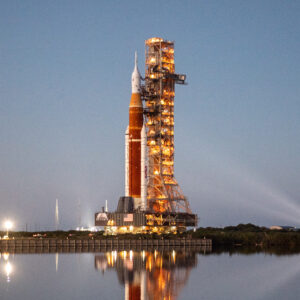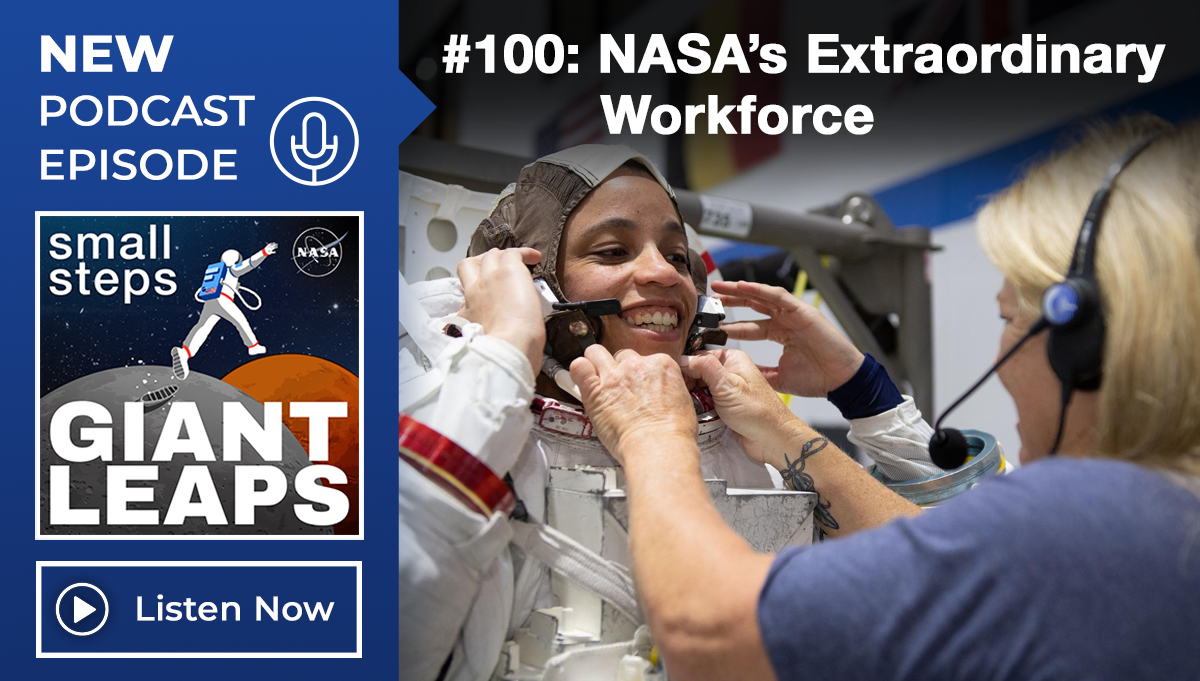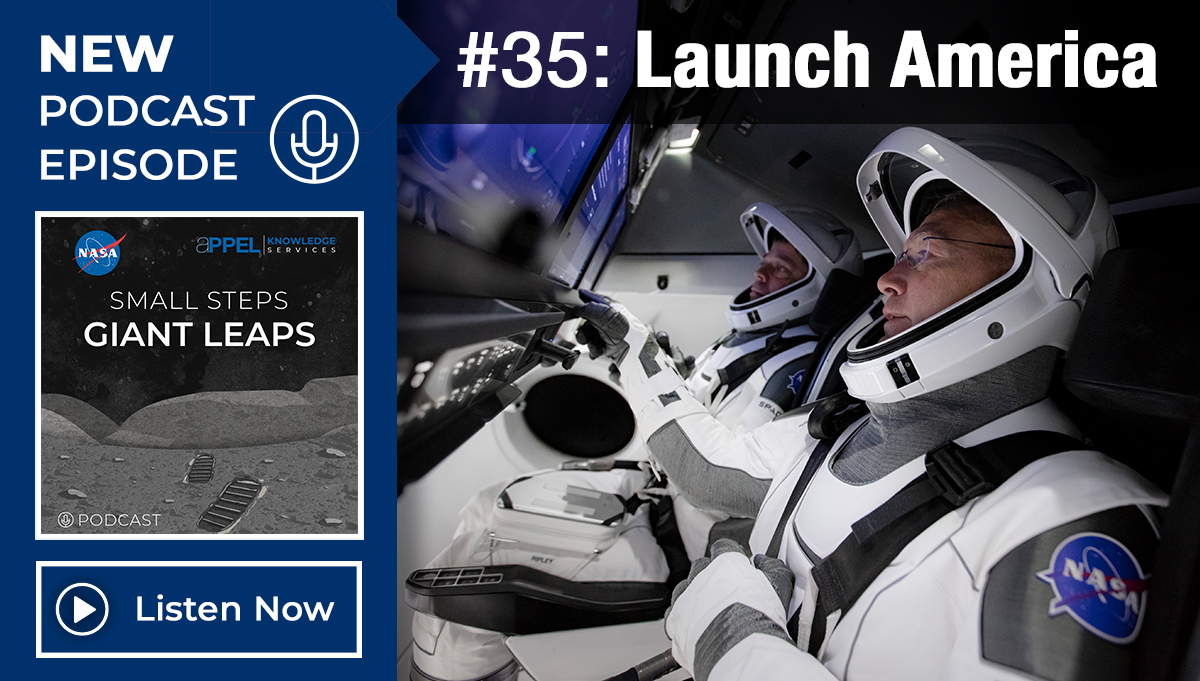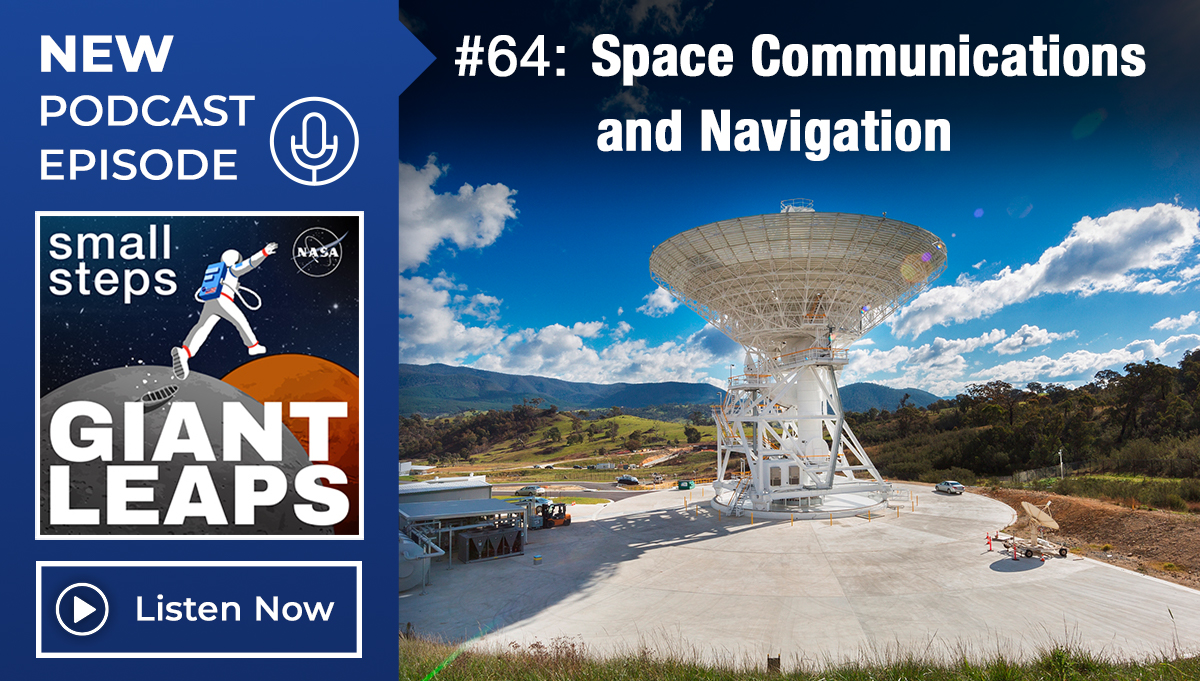
NASA Administrator Bill Nelson and NASA Deputy Administrator Pam Melroy speak with media during a visit to Stennis Space Center on Dec. 7, 2021, standing in front of an Aerojet Rocketdyne RS-25 engine like the ones that powered the Space Shuttle and now the Artemis program’s Space Launch System.
Credit: NASA
100th podcast episode features Deputy Administrator Melroy.
APPEL Knowledge Services reached a milestone in January, releasing the 100th episode of the Small Steps, Giant Leaps podcast, welcoming NASA Deputy Administrator Pam Melroy for an interview that touched on NASA’s extraordinary workforce, the importance of lessons learned, upcoming X-plane flights, and maintaining a culture of safety.
Following NASA’s successes in 2022, which included deployment of the James Webb Space Telescope and the first spaceflight of the Artemis program, Melroy discussed major milestones ahead in 2023, including the first flights of the X-57 and X-59 research aircraft.
“…It will be great to see our aeronautics portfolio get back into the X-plane business with the first flight of two X-planes. As a test pilot I find that very exciting,” Melroy said. “Also, I’m really looking forward to adding a new capability to our Human Spaceflight Program. We hope that Boeing will send the first crew on their Starliner to the International Space Station. … I am thrilled every time we add a new spacecraft — and we have a lot of them now — but this is really very exciting.”
Podcast host Deana Nunley asked Melroy how the people of NASA have been able to continually reach further and achieve what was previously only imagined.

Astronauts Pam Melroy (left), STS-120 commander; Peggy Whitson, Expedition 16 commander; and Stephanie Wilson, STS-120 mission specialist, pose for a photo in the Zvezda Service Module of the International Space Station while Space Shuttle Discovery is docked with the station.
Credit: NASA
“Well, I think there’s a very important cultural aspect to this,” Melroy replied. “It goes back to our formation and our roots and the history in the ‘60s. I mean, it was really unfathomable. I mean, people had absolutely no idea, no basis for making an assertion that we were going to send a man to the Moon and bring him home safely. But I think it really created a culture inside NASA of, once we decide there’s a goal that we’re going to do, we just go do it. And so, to me that is, that’s very central to our culture.”
Melroy is an accomplished aviator with more than 6,000 flight hours. Selected as an astronaut in 1994, she was the pilot for space shuttle missions STS-92 in 2000 and STS-112 in 2002. In 2007, she was commander of STS-120—making her one of only two women to ever command a space shuttle flight. She was sworn in as NASA Deputy Administrator on June 21, 2021.
As a former military officer, Melroy was placed into leadership roles early in her career and takes leadership seriously. She said she has developed a servant leadership mentality, supporting the mission, the people working on it, and the crew. Astronauts, she noted, have a unique perspective on NASA’s complex missions.
“…There are people who know how to launch rockets and to build spacecraft and to integrate payloads and so forth, and you get a strong expertise in those areas, but the astronaut gets to see how it all comes together at the end. So I feel a little bit that way in a leadership position of the agency, I get to see how it all comes together, and that’s what’s really fascinating,” Melroy said.
She concluded the podcast by saying she is incredibly proud of NASA’s workforce.
“I have worked inside NASA and at a lot of other places in industry and government. I’ve worked around the world, and this is an extraordinary workforce. Their technical capability is unparalleled. If you have a problem anywhere in the world, eventually somebody will say, ‘Hey, let’s call NASA.’ And amazingly, we will have someone who can help and does help and will help. And it just makes me so proud to be part of the organization.”
APPEL KS debuted the Small Steps, Giant Leaps in December 2018 as a new way to highlight project experiences for NASA’s technical workforce. The title echoes the iconic words Neil Armstrong spoke as he stepped onto the surface of the Moon and was chosen to emphasize how small steps pave the way to giant leaps forward in knowledge, innovation, science, and exploration. The biweekly podcast features interviews and stories that take listeners inside NASA projects, highlighting lessons learned, best practices, and novel ideas from the teams who are advancing space exploration, aeronautics, and Earth sciences.

NASA’s Space Launch System (SLS) rocket with the Orion spacecraft aboard is seen atop a mobile launcher as it rolls out to Launch Complex 39B for the first time, Thursday, March 17, 2022.
Credit: NASA/Keegan Barber
“By developing the Small Steps, Giant Leaps podcast, APPEL KS created a fresh, new way to share best practices, lessons learned, and project experiences with NASA’s technical workforce,” said Steve Angelillo, APPEL KS Deputy Director. “They appreciate how engaging the episodes are and that they can take the podcast with them and listen when it fits their schedule. It has been gratifying to watch the audience growing as we’ve shared so many great stories from across NASA.”
Over the past 100 episodes, the podcast has covered a wide array of topics, from artificial intelligence to astronaut training, from designing spacesuits for the surface of the Moon to the effects of space radiation. Engineers and scientists have discussed NASA missions, including Artemis I, the Ingenuity helicopter flying on Mars, the Perseverance Rover exploring Jezero Crater, the OSIRIS-REx mission returning asteroid samples to Earth, and the upcoming DAVINCI and VERITAS missions to Venus. In a special, four-episode series in early 2022, Nunley interviewed NASA chief engineers about best practices.
“When APPEL KS Deputy Director Steve Angelillo conceived the idea for this podcast, I don’t know that anyone on our team could have envisioned the depth of knowledge and experience that would be shared,” Nunley said. “Our guests have told one fascinating story after another, offering expert insight into NASA missions and giving our listeners an opportunity to hear inside accounts of project management, engineering decisions, and lessons learned.”
Upcoming episodes will focus on a wide variety of topics, including inaugural X-plane flights, perovskite solar cells, workplace safety culture, and contributions welders and other technicians make to NASA missions.
Small Steps, Giant Leaps is available on the APPEL KS website, as well as the Apple, Google, SoundCloud, and iHeartRadio podcast platforms.









